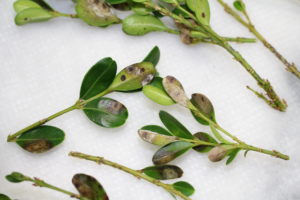A decade ago, boxwoods (Buxus spp.) were the quintessential shrubs, particularly for formal hedges. Over the past half century, many new boxwood varieties have been introduced into nursery commerce, a boxwood variety that will work in most garden situations. Just five years ago, boxwood production at U.S. nurseries was greater than for azaleas, hollies, hydrangeas, and arborvitaes.
The impact of boxwood blight (Calonectria pseudnaviculata) on sales has been crippling. Professional landscapers and homeowners can no longer be certain that they are purchasing diseased plants, that may contaminate healthy boxwoods already planted on site. While other diseases and pest problems – such as Volutella canker (Volutella buxii) and boxwood leafminer and midge – injure boxwoods, boxwood blight has become the foremost concern here in the U.S. and around the world.
Boxwood blight can be found on container and landscape-grown plants, as well as on greenery and wreaths used for Christmas decorations. All popular boxwood cultivars are thought to be susceptible to infection, although they do vary in susceptibility. Boxwood relatives, such as Japanese spurge (Pachysandra terminalis), Allegheny spurge (P. procumbens), and Sweetbox (Sarcococca spp.), are also susceptible to boxwood blight.
Research has determined that the fungus that causes boxwood blight usually moves short distances, mostly by rain splashing or wind driven rain. The fungal spores are large and are not carried via air currents. Nurserymen and landscapers are cleaning tools, work boots, and gloves when working with boxwoods in the field to prevent its spread. Drip irrigation systems are preferred rather than overhead systems. Mulching around plants reduces rain splash and distribution of boxwood fungus. Fungicide applications slow down disease spread, but do not eradicate the disease.
Field and landscape sanitation is most important. After hedging (or pruning) boxwoods, disinfect tools with bleach, ethanol (rubbing alcohol), Lysol®, and others. Awareness and better diagnoses are important criteria at garden centers. Consumers should avoid purchasing suspicious boxwoods if the foliage looks discolored or leaf drop is significant.
Still no sure? Collect boxwood samples (see picture above) and send them to your local Extension office.


 Posted in
Posted in 
